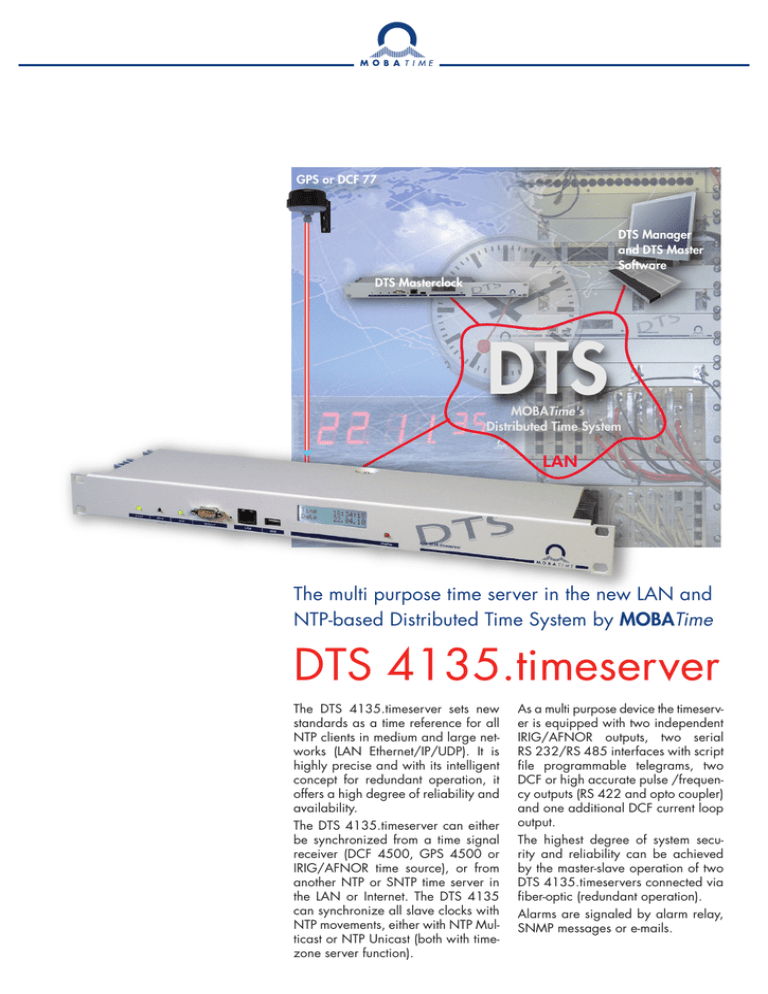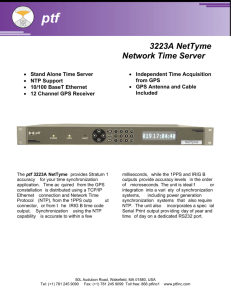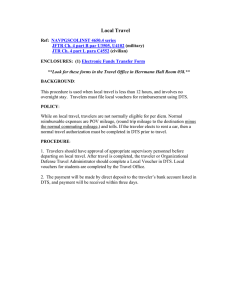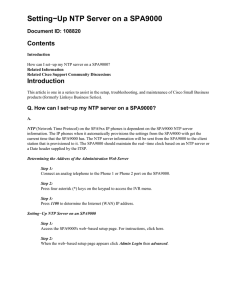DTS 4135.timeserver
advertisement

GPS or DCF 77 DTS Manager and DTS Master Software DTS Masterclock DTS MOBATime's Distributed Time System LAN The multi purpose time server in the new LAN and NTP-based Distributed Time System by MOBATime DTS 4135.timeserver The DTS 4135.timeserver sets new standards as a time reference for all NTP clients in medium and large networks (LAN Ethernet/IP/UDP). It is highly precise and with its intelligent concept for redundant operation, it offers a high degree of reliability and availability. The DTS 4135.timeserver can either be synchronized from a time signal receiver (DCF 4500, GPS 4500 or IRIG/AFNOR time source), or from another NTP or SNTP time server in the LAN or Internet. The DTS 4135 can synchronize all slave clocks with NTP movements, either with NTP Multicast or NTP Unicast (both with timezone server function). As a multi purpose device the timeserver is equipped with two independent IRIG/AFNOR outputs, two serial RS 232/RS 485 interfaces with script file programmable telegrams, two DCF or high accurate pulse /frequency outputs (RS 422 and opto coupler) and one additional DCF current loop output. The highest degree of system security and reliability can be achieved by the master-slave operation of two DTS 4135.timeservers connected via fiber-optic (redundant operation). Alarms are signaled by alarm relay, SNMP messages or e-mails. DTS 4135.timeserver - the innovative, precise time reference for networked, multifunctional systems Time precision Best accuracy can be achieved by synchronizing the DTS 4135 via a connected GPS receiver. The internal time is adjusted to the time reference (e.g. GPS) in one step or continuously (adjustment speed configurable) to avoid any time leaps (e.g. after a longer loss of the time source), thanks to the intelligent time management. To achieve utmost accuracy, the quartz drift and aging is continuously compensated. Top performance - even for large networks The high performance DTS 4135 timeserver can answer more than 250 NTP and SNTP requests per second. It can also work as an NTP time reference for a subnetwork, being synchronized from a superior NTPServer (client and server at the same time). Secure NTP Supports NTP authentication for increased security, which allows clients, to verify the received NTP packets. Safe, convenient operation After configuring an IP address via serial interface (terminal program), operation over LAN via Telnet, SSH or SNMP protocols is possible. SSH and SNMP (MD5 authentication and DES for encryption) enable a secured connection. Special software is required for operation by SNMP protocol. Effective fault indication Alarms are reported by alarm relay, by e-mail, or via SNMP messages. Additionally, the display can be used to check the alarm state by pressing the red push button. Front view Connectors: • LAN connector RJ 45, 10/100 Mbit • PC terminal connector, RS232 Sub-D 9p male • USB connector for software update, maintenance or file download to the timeserver (e.g. telegram files, timezone table ...) LEDs: Mains power, alarm, synchronization and network transmission control. Display: Time, date, status, alarm, IP... Rear view Connectors: • Power: Mains power connector, 2 DC power supply inputs, DC output (e.g. for GPS) • Alarm: alarm relay contact, alarm input • Synch. inputs: IRIG-B/AFNOR input (BNC), DCF current loop • Synch. outputs: DCF current loop, DTS link (GBIC-module) • Serial: 2 RS 232/485, both for script file progr. serial message • IRIG: 2 IRIG-B/AFNOR outputs (BNC) • IRIG DC: 2 DC level IRIG-B/AFNOR outputs (both RS 422 & current loop) • Pulses: 2 DCF or pulse/frequency outputs (both RS 422 & current loop) DTS device mounted in a 19” IT-Rack DTS 4135.timeserver - the time source for LAN-based clock and time distribution systems The DTS 4135.timeserver is a versatile time reference in several respects. On one hand, it relays the external time signals with maximum precision and reliability. It is compatible with all NTP unicast (IP based) or multicast devices, such as slave clocks with NTP movement (e.g. NBU 190), digital clocks and digital information displays with NTP synchronisation. On the other hand, it can also synchronize the NCI (Network Clock Interface), which for its part can control master clocks and slave clocks with MOBALine and DCF 77 input. Even PCs/workstations, photocopiers, printers, fax equipment, time recording terminals, and access control systems, central fire alarm systems, image and sound recording equipment, and many other „clients in the network“ can be directly synchronized by means of the NTP protocol. DTS Manager DTS 4135.timeserver NTP NTP DTS Masterclock NTP LAN WAN NTP NTP NTP NTP DTS 4135.timeserver - greatest priority for security and reliability Redundant operation Redundant power Redundant outputs To avoid time deviation between two DTS 4135.timeservers, they can be linked via a fiber-optic connection by using two GBIC modules. The two timeservers automatically negotiate their state as master or slave. The slave is always synchronized by the master. In case of GPS failure, an automatic swap between master and slave state will occur. The parameters for the swap can be configured. The “master” DTS timeserver always has the better NTP stratum level than the slave. The DTS 4135.timeserver has several monitored power inputs for completely redundant power supply. The non-active power supply input is also monitored. Possible power variants: • 24 VCD, non-redundant • 230 VAC, non-redundant • 24 VDC + 24 VDC, redundant • 230 VAC + 24 VDC, redundant Redundant IRIG-B/AFNOR, serial telegram, DCF and/or pulse/frequency outputs can be achieved by the External Change Over unit (ECO). Master GBIC modules Slave 24 VDC 24 VDC 85 - 265 VAC Monitored inputs LAN WAN DTS 4135.timeserver, versatile high precision master clock and NTP time server DTS 4135.timeserver e.g. as NTP server and master clock for high precision IRIG-B/AFNOR outputs, for RS 232/485 serial messages and technical pulses or frequencies. Time signal receiver Central monitoring Redundant NTP Server DTS 413x.timeserver SNMP, E-mail GPS 4500 DCF 4500 LAN / WAN NTP Services NTP Clients Process controller Voice recording Audio and image recording Building automation High precision DCF, Pulse or Frequency ouputs digital clocks Computers RS 232/485 serial outputs Analogue and IRIG-B/AFNOR/DCF-FSK Process controller / Computers Process controller Building automation Sub-Master Clock DTS 4135, AFNOR synchronized The DTS 4135.timeserver is equipped with two IRIG-B/ AFNOR outputs to control analogue and digital slave clocks, process controllers, voice recording systems and many other technical equipment. Typical application e.g. for power distribution stations or energy production plants, where high reliability, high precision, no time leaps and permanent availability are required. The DTS 4135.timeserver is further equipped with two RS 232/485 serial outputs. Programmable messages with script file allow for synchronization of any kind of technical equipment like e.g. computer server, process controller, fire supervision system, ... To increase the precision of the synchronization, two high accurate pulse outputs are provided. They can either be used as DCF outputs (RS 422 and opto coupler) or periodical pulses. Typical application e.g. for power distribution stations or energy production plants, industries... DTS 4135.timeserver - Technical and performance details Technical Data DTS Link (Redundancy) NTP-slave clock line Network services Network Interface IP configuration Operation LED indication Display Local time calculation Accuracy Time-keeping (internal) DTS 4135 -> TCXO DTS 4136 -> OCXO External time source Alarm relay Alarm input Power supply Dimensions Weight Power reserve Ambient temperature Options NTP V4 (fully V3 compatible) / SNTP, NTP multicast DCF-time signal output (opto coupler passive) 2 x IRIG-B/AFNOR output, each with analogue (BNC) and DC level (RS 422 and opto coupler) output 2 x DCF 77, programmable pulses/frequencies (RS 422 and opto coupler) 2 x RS 232/485 serial message programmable by script file Max. length of the fiberglass cable, e.g. multimode fiber Ø 50 μm: multimode fiber Ø 62.5 μm: For slave clocks synchronized by NTP multicast or unicast (IP based). Timezone server function with up to 15 different time zone entries. NTP client NTP server, max. no. of NTP and SNTP client requests: SNMP V1, V2c, V3 (get, put, notification, trap) with MD5 authentic. and DES for encryption E-mail for alarm messages (2 addresses possible) DATE, TIME, FTP (for update) 10BaseT / 100BaseTX (IEEE 802.3) Data transmission rate: auto-negotiation / manual Connection: RJ45 (only shielded cable permitted) DHCP, static IPv4, IPv6 Serial terminal via RS 232 (front side, sub-D 9p male) Via LAN: Telnet, SSH, SNMP (special software necessary) USB connector for software update, maintenance (config. and log files upload) or file download (e.g. telegram files...) Power supply, synchronization status, LAN status, alarm, DCF input Display for status information: Time, date, IP, alarm... (2 lines with 16 characters) Automatic, preprogrammed daylight saving time change. Up to 80 pre-defined time zone entries and 20 user-definable entries. All outputs can be individually allocated to a time zone (UTC or local time) GPS (DCF input) to NTP server: GPS (DCF input) to DCF 77 / pulse output: NTP to internal time: Redundant operation: master to slave GPS (DCF input) to IRIG (analogue) GPS (DCF input) to IRIG (digital) Internal time to serial outputs (jitter: +/- 10ms) Synchronized with GPS: Hold over (after >24h synch. from GPS) at 20°C +/- 5°C: Hold over (after >24h synch. from GPS) at const. temp.: After restart without synchronization (for 24 hours) at 20°C +/- 5°C: Hold over (after >24h synch. from GPS) at 20°C +/- 5°C: External NTP / SNTP server (4 NTP sources possible), and / or DCF 77- time signal receiver (opto coupler, e.g. DCF 4500), or GPS time signal receiver (opto coupler, e.g. GPS 4500), or IRIG-B/AFNOR (analogue), or manual time setting (only for test purposes) Potential free, opening contact for signalizing disturbances 1 alarm input for monitoring of an external device, 18 - 36 VDC, max. 6 mA AC input: 85 to 265 VAC / 50 - 60 Hz / max. 15 VA 2 x DC input: 24 VDC + 20 % / - 10 % / max. 10 W DC output: nominal 28 VDC, max. 400 mA 19“ rack, 1 rack unit, W x H x D mm IRIG-B122, IRIG-B123, AFNOR A, AFNOR C, DCF-FSK, ... max. 550 m max. 275 m typical > 250 requests/sec typical < +/- 100 μs typical < +/- 10 μs typical < +/- 100 μs typical < +/- 1 μs typical < +/- 100 μs typical < +/- 10 μs typical < +/- 10 ms +/- 10 μs to UTC < +/- 10 ms/d or < 0.1 ppm < +/- 1 ms/d or < 0.01 ppm < +/- 250 ms/d or < 2.5 ppm < +/- 1 ms/d or < 0.01 ppm open -> alarm input open -> alarm 483 x 44 x 125 approx. 1.8 kg No internal active running reserve, timekeeping with RTC for short power outages none -5 to 50°C, 10 - 90 % relative humidity, without condensation Mini GBIC module (GigaBit Interface Converter) SX LC 1000Mbps, 3.3V fibre optic cable, 2xLC/LC50/125µm patch cable FibreChannel duplex 100 cm MOSER-BAER AG CH-3454 Sumiswald/Geneva, Switzerland www.mobatime.com LE-800720.01 Time signal outputs




